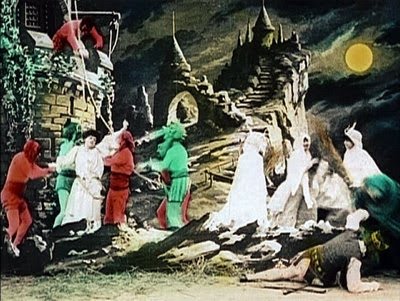 Photo du film "Le Repas fantastique" (1900) de Georges Méliès via Wikimedia Commons Photo du film "Le Repas fantastique" (1900) de Georges Méliès via Wikimedia Commons
Georges Méliès (1861-1938) was a pioneer of French cinema. An illusionist, he brought true magic to film by inventing and popularising special effects such as time-lapse photography, hand-painted colour, and multiple exposures. Le voyage dans la lune (A Trip to the Moon) and Voyage à transfers l'impossible (The Impossible Voyage), some of his most famous works, are considered to be the first science fiction films.
Méliès' path to filmmaking was a rocky one; his family wanted him to continue in the family shoe business, and he did, for a while. His father sent him to London to work as a clerk, and there he started visiting The Egyptian Hall, run by famous illusionist John Nevil Maskelyne. Young Méliès returned to Paris with a passion for stage magic and a desire to study painting at the École des Beux-Arts. His father flatly refused to support that kind of nonsense, so Méliès settled for working at the family factory by day and cultivating his interest in stage magic by night at the Théâtre Robert-Houdin. He also started taking magic lessons and performing.
In 1888 his father retired, and Méliès sold his share of the shoe business to his brothers. Together with his wife's dowry, he used the money to purchase the Théâtre Robert-Houdin. (I imagine this didn't go down well with Méliès senior...) Living the dream got off to a rocky start when attendance at the theatre was low, but Méliès wasn't easily discouraged: over the next nine years he invented over thirty new illusions and attendance improved. But Méliès didn't only perform on stage; he also worked as an editor, writer, and set and costume designer, gathering crucial experience for the years to come.
On the evening of 27th December 1895 Méliès' world changed forever when he attended a private demonstration of the Lumière brothers' cinematograph and offered the ten thousand francs for it at the spot, but the brothers refused to sell. Méliès finally obtained a similar device from Robert A. Paul in London, and, after some modifications, he finally had his film camera. He developed his films personally and learned the business of filmmaking by trial and error. Technology finally caught up, and in 1987 Méliès was able to purchase a better camera. Between the years of 1986 and 1913 he made over five hundred films and started his Star Film Company.
|
 Photo du film "Le Dirigeable fantastique" (Méliès, 1906) via Wikimedia Commons Photo du film "Le Dirigeable fantastique" (Méliès, 1906) via Wikimedia Commons
The story has a sad ending, though. In 1903 film critics pronounced Méliès' work declining and repetitive. Also, in 1908, Thomas Edison created the Motion Pictures Patent Company to control the film industry in the US and in Europe, and Méliès was obliged to supply it with one thousand feet of film per week. In 1909 Méliès stopped making film, but he presided over the first International Filmmakers Congress in Paris. Unhappy with Edison's monopoly, the filmmakers tried to fight back. In the end, they came up with the idea to stop selling films, leasing them instead. Méliès resumed filmmaking, but the majority of the company's films were made by his brother Gaston, who had left France to start his own branch of the company in the US.
In 1910 Méliès toured Europe with the stage magic show Les Fântomes du Nil, and made an agreement with Gaumont Film Company to distribute Star Company's films. Then he made the worst mistake of his career: he accepted a large sum of money from Charles Pathé to produce films, giving the Pathé brothers the right to distribute and edit them. As a part of the deal, Méliès handed over the deeds to his home and his studio.
After many unsuccessful films, and the final insult of Pathé handing over a film for editing to Méliès' rival Ferdinand Zecca, Méliès broke contract with Pathé in 1913. On top of that, Gaston Méliès had messed up: he squandered fifty thousand dollars on his travels over the globe, producing only unusable or damaged film footage. He couldn't fulfil Star Film's obligation to Edison's company, and had to sell the American branch of Star Films. The brothers never spoke to each other after that. This left Méliès with nothing to pay his debts to Pathé.
Then came the First World War, and Méliès' wife walked out on him, leaving Méliès to raise his thirteen-year-old son alone. The army confiscated over four hundred of Star Company's original films and melted them to reclaim the silver and celluloid, which were used to make heels for shoes. In 1923 Pathé was finally able to take over Méliès' studios. Méliès flew into a rage and burned all the negatives he had stored at the studio, and most of the sets and costumes. Only two hundred films were saved. |
 |
| photo du film "Le royaume des fées" (1903, Méliès) via Wikimedia Commons |
The images above are from Méliès' films, but stills aren't enough to convey how amazing they are; you need to see them in motion. You can view them at archive.org, but here's a taste:
Alchimiste Parafaragamus ou La cornue infernale By Georges Mélies (Internet Archive) [Public domain], via Wikimedia Commons
Sources:
Wikimedia Commons
https://en.wikipedia.org/wiki/Georges_Méliès
No comments:
Post a Comment
Hello, stranger. What's on your mind?